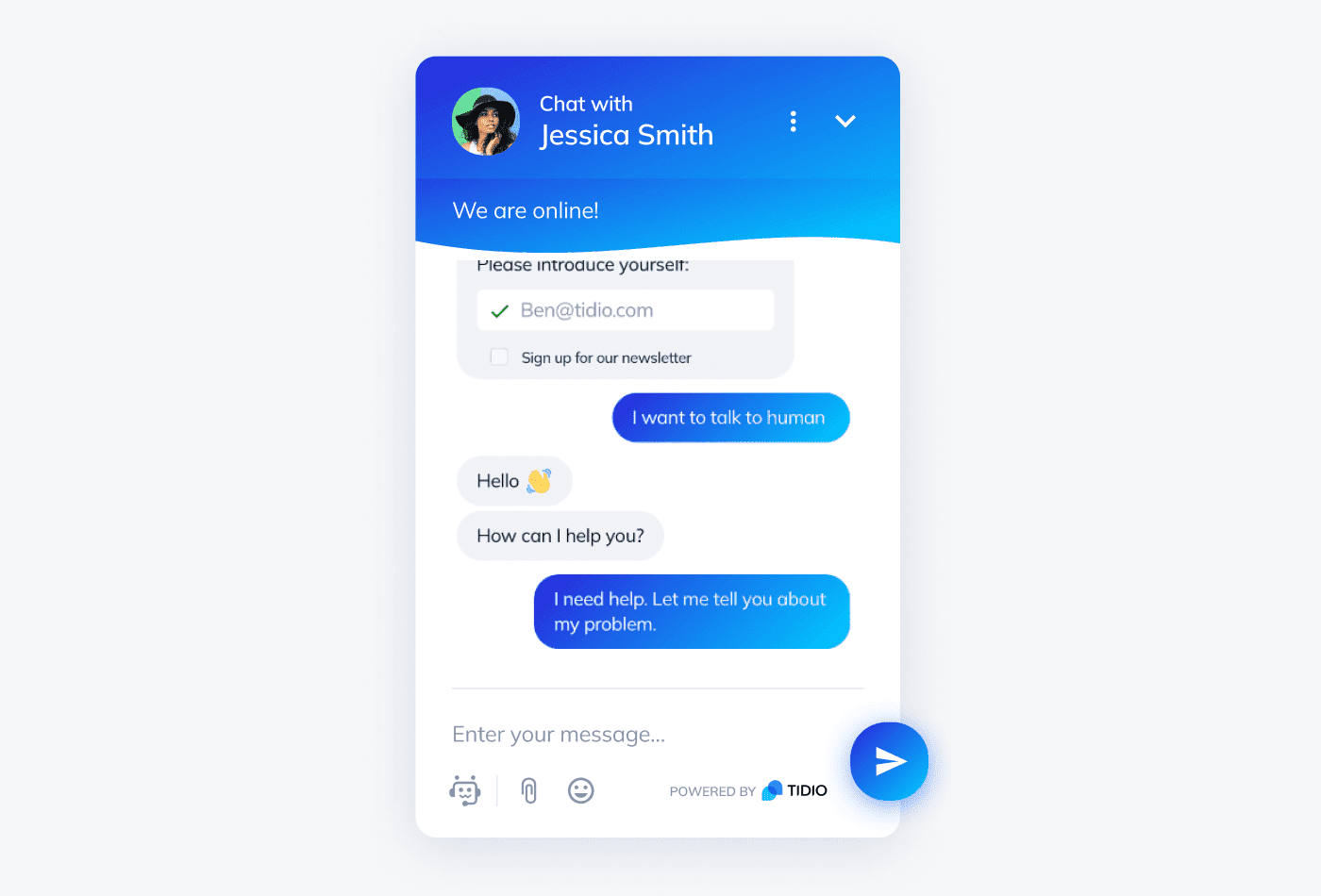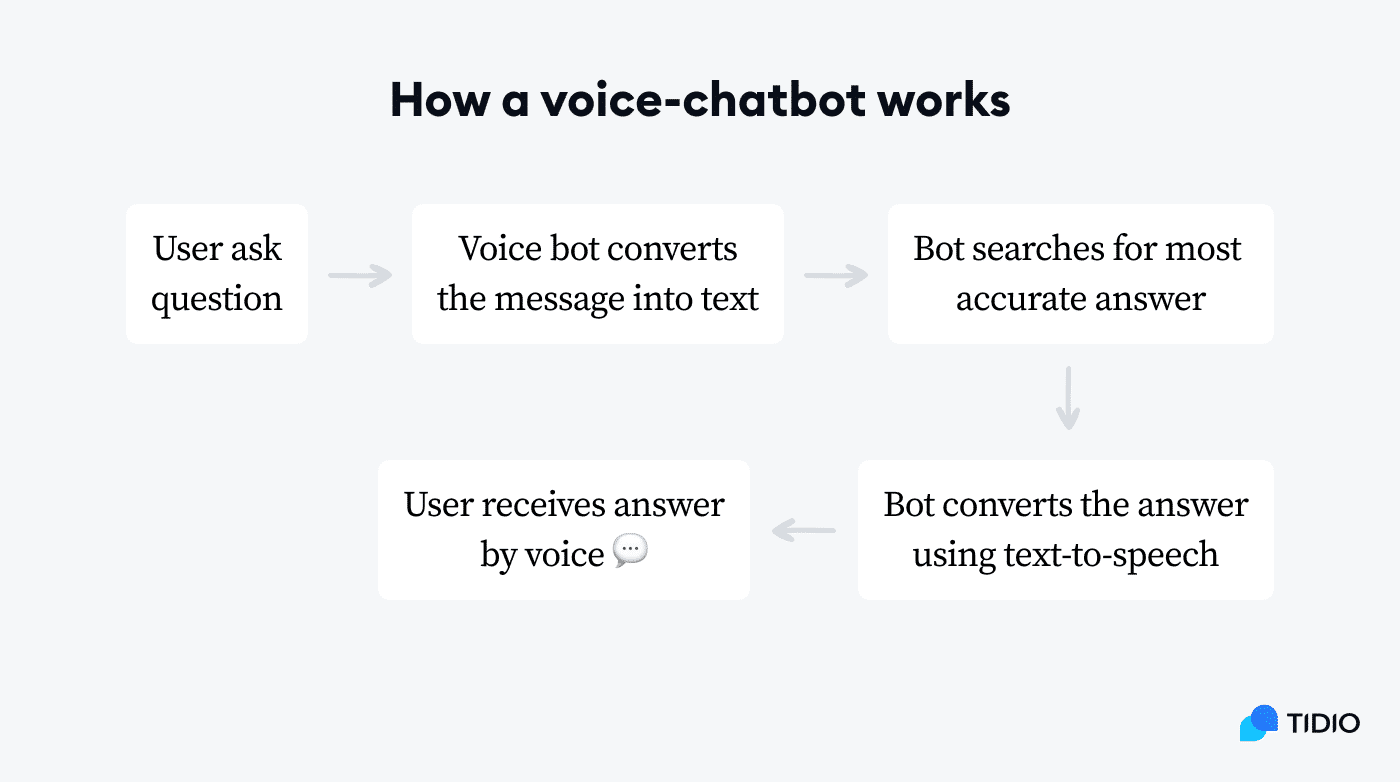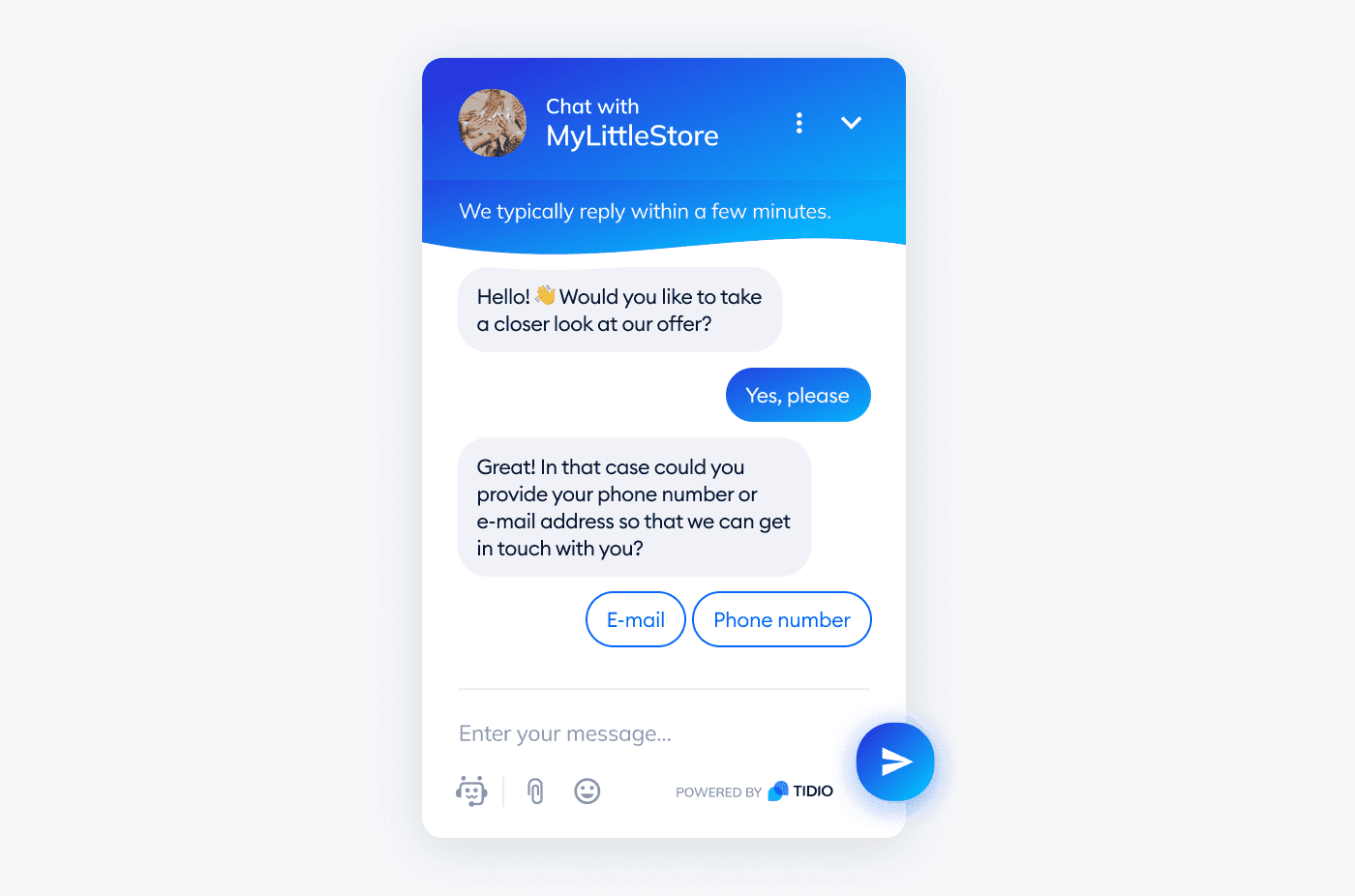Chatbots are types of computer software capable of answering customers’ queries by simulating human conversation, usually through text messages or voice commands.
From rule-based bots to virtual assistants, these technologies are becoming the standard of web interactions. Businesses are using them to engage their clients, improve customer service, and enhance the user experience.
But what is the difference between various types of chatbots, and most importantly, which one should you choose to reap all their benefits?
Stay tuned as we explore chatbot classifications according to their capabilities.
In this article, we’ll talk about the following types of bots:
Improve customer engagement with chatbots
Do you want to explore the topic of chatbots even further? Check out these articles:
- How to Create a Chatbot for Free [No Coding]
- Creative Chatbot Ideas to Boost Your Online Business
- 15 Best Chatbot Software for Your Website
You must be wondering—
How many types of chatbots are there?
But before mentioning all the different types, it’d be good to distinguish between various bot classifications first.
Basic classification of chatbot technologies
Most often, people divide chatbots into two main categories—rule-based and AI bots.
Let’s take a quick look:

Rule-based chatbots usually provide users with different options they can explore. A website visitor can click on a category they are interested in to get an answer or info related to a particular query. These types of bots are most often used for simple tasks like replying to frequently asked questions (FAQs).
AI-based bots use artificial intelligence (AI), natural language processing (NLP), and machine learning (ML) technologies and algorithms to understand different keywords users type in when chatting with them. These chatbots get trained over time and learn which responses they should provide according to user queries.

Thanks to this advanced technology, AI-powered chatbots can offer assistance to your customers and automate answers in a way that is more personalized and natural as a whole.
Businesses strive for customer relationships based on empathy and connection, built through human-to-human interaction. Yet, automation is something that provides scalability. That's where AI chatbots come into play. They can help automate natural-sounding conversations without a robotic feel.

Aside from these two types of chatbots, there’s another classification that adds one more type into the mix—hybrid chatbot.
As their name suggests, hybrid chatbots are a mix of simplistic, rule-based bots and advanced, context-aware ones. They combine the strengths of both types of chatbot technology. Namely, these bots can handle common, repetitive queries for immediate assistance, but they can also understand questions that require some judgment. If human intervention is needed, they can direct tricky conversations to human agents while automating most mundane requests like order status checks, address changes, etc.
The dual-strength nature of these bots makes them powerful and versatile tools for businesses across industries, allowing them to optimize customer service and support at scale.
Okay—
Time to dive into the topic a bit further.
Chatbot types
To make things even clearer, let’s take a look at another, more detailed chatbot classification.
We’ve divided our list of chatbots according to specific functionalities and technologies used to decipher user intent and queries.
Without further ado, here are chatbot technologies you should know more about:

1. Menu-based chatbots
Menu or button-based chatbots are some of the most commonly used bot types out there. Generally speaking, they use the so-called decision tree type of logic, which is usually displayed as a list of menu buttons to users. Then, a user can pick an option that best corresponds with their inquiry to find an answer they are seeking.

These types of chatbots work great for answering simple customers’ FAQs. That being said, they may not be as sufficient if users require more detailed answers.
If you own an online store of any kind, some of the frequently asked questions by your visitors may include things like wanting to track their order, learning more about your prices, checking available discounts, etc. Button-based bots may come particularly handy in these cases.

2. Rule-based chatbots
We’ve already mentioned rule-based, or keyword recognition-based chatbots earlier. But let’s go ahead and explore this bot type even further.
This is a perfect fit for businesses that know well which queries they can receive from their customers. Otherwise known as linguistic bots, rule-based chatbots work on the principle of if-then logic that helps them create conversational automation flows.
The if-then logic works by adding specific words that will trigger appropriate answers by this kind of bot. To make it as precise as possible, there are certain conditions that can be created. These include adding synonyms, specific order sequences of the words, etc.
If a customer uses a word or phrase that can be found within the list of established language parameters, then a bot will provide the appropriate answer.

For example, you can train a rule-based chatbot to give an answer about the product pricing if a client uses any of the following words in their question:
| How much does your product cost? What is the cost of your product? What is your pricing? What are the prices available? |
You get the idea.
3. NLP bots
NLP chatbots use natural language processing (NLP) technology that helps them understand human language. In turn, it allows a bot to fully interpret the user’s intent and respond to their queries in the best way possible.
To help you understand the capabilities this type of bot possesses, let’s do a quick comparison with previously mentioned rule-based chatbots.
A more traditional, rule-based bot only understands the query provided by the context of a specific keyword. On the other hand, an NLP chatbot can understand the entire context of user intent.

Say that a customer asks a rule-based chatbot to share shipping info related to your business. Since it’s trained to provide an answer according to the “shipping” keyword, it’s supposed to give you accurate info on this particular subject.
But what would happen if a person were to ask for something more specific, like “What is the shipping rate for FedEx”, for example?
You guessed it—a rule-based bot would only be able to share the same answer as above, only recognizing the keyword “shipping”.
So, unlike rule-based bots, NLP chatbots will understand the more specific user input and will be able to come up with the appropriate reply, answering the user’s question in its entirety.
Read more: Explore more about the NLP technology used in the Tidio AI chatbot.
Automate client conversations using chatbots
4. Machine learning bots
Contextual or machine learning (ML) chatbots are among the most advanced ones of the bunch. These bots use machine learning (ML) and AI technologies to memorize conversations made with specific users. By doing so, they have the potential to learn and develop even further with time.
In other words, the more user interactions the ML bot has, the more it’s capable of improving on its own.
A contextual chatbot can save any data from past conversations, such as the customer’s shipping address, billing info, and any other preferences made during the chat.
Say that a visitor has already interacted with an ML bot while making their order. If the same user wants to make the order again, the contextual chatbot can simply ask whether they want to use the same preferences already saved in its database.

In short, ML chatbots hold plenty of potential for personalization. As such, they can help your brand to make customers feel more valued, which is a huge plus for any business that wants to maintain customer loyalty.
Read more: Explore the topic of AI chatbots and find out the best examples for business and personal use. Also, check out tips that will help you learn how to train your AI.
5. Hybrid chatbots
Hybrid bots use a mix of AI and rule-based chatbot technologies to provide the best possible assistance to users and answer questions. As such, these are the most practical kinds of AI on our list.

What’s also great about hybrid chatbots is that they allow you to use the chatbot and live chat technology simultaneously. This means that a bot can simulate real-life conversations based on queries up until the moment a more complex request is made. In this case, one of the service agents from your support team can replace the chatbot and quickly help a client out without disrupting the flow of conversation.
Read more: Learn the core differences between chatbot vs live chat and determine which one is best for your business.
6. Voice bots
Simply put, voice chatbots represent a type of conversational AI that acts as a virtual assistant. They use speech-to-text and text-to-speech functions, as well as AI and natural language understanding (NLU) technologies to recognize user queries.
They are useful as they can offer answers to all sorts of questions and queries without a user having to type anything at all. It’s quite convenient—all a person has to do is ask their inquiry or question out loud using their mobile device or computer.
The audio message made by the user is converted to text so that the bot can decipher the user intent. After searching the engines for the most accurate answer, a voice bot will convert said answer using text-to-speech. Finally, the person will receive their answer by voice within seconds.

It’s also worth knowing that voice bot types can be further classified into:
- Hybrid bots, which are controlled by both text and voice
- Voice-only bots, which are only controlled by a voice
Read more: Explore the differences between chatbots and conversational AI and determine your business options. Also, be sure to check out the comparison of chatbots vs. virtual assistants.
As you can see, there are many different kinds of chatbots available that you can implement into your business model according to your needs.
But, let’s be even more specific and dive into some practical examples of how you can use these bots.
Useful chatbot showcases
There’s hardly any online business nowadays that isn’t using some type of chatbot to automate conversations, streamline customer service, and enhance relationships with clients. Let’s explore some of the ways in which different chatbot entities can be implemented.
1. Information (FAQ) bots
We’ve already mentioned an FAQ chatbot in the context of a menu-based bot type. Plenty of businesses have some kind of information chatbot setup on their website. In fact, information chatbots are most popular in healthcare (64%), communications (59%), and banking (50%) industries.
And there’s no shortage of information you can add with this chatbot type. You can use it to answer the most frequently asked questions related to your brand, like offering product and service info. They can also help you create a knowledge base, display pricing, and plenty more.

For example, restaurant businesses can easily implement this kind of bot and get customers introduced to their menu. They can offer information regarding the reservation process, provide means of contact, display opening hours, and so on.
Read more: Learn all about an FAQ chatbot and discover how it can benefit your business in more detail. Also, make sure to check out some practical restaurant chatbot use cases.
2. Sales chatbots
As their name suggests, these bots have the potential to increase sales and boost revenue. You can do this by getting a sales chatbot to recommend products to customers, introduce special, personalized offers or discounts, and more. This chatbot can even gather emails and urge visitors to convert, all the while doing it in a natural and conversational way.
Thanks to their machine learning technology, sales bots are capable of creating a personalized experience when sending notifications. This can help customers feel more appreciated as a whole. In turn, this can increase your chances of boosting revenue and improving customer experience in the long run.

For example, if a user has purchased a pair of sneakers before, a sales bot will process this info in its database and will be capable of suggesting another model from the same brand. Or, it can offer a discount on another, new pair with a similar style a client seems to go for.
Read more: Check out this case study and learn how Ad Hoc Atelier boosted their sales using Tidio.
3. Lead generation bots
These chatbots use their conversational abilities to gather useful info from website visitors. They can offer assistance when it comes to the purchase process, provide answers to various questions, and proactively reach out to customers once they make a specific action using chat triggers. Of course, these bots can also help you qualify leads. They do so by collecting phone numbers and email addresses, getting visitors to subscribe, and more.

Not only do lead generation chatbots allow you to capture quality leads, but they also improve customer engagement. Plus, they help you form lasting relationships with your clients.
Read more: Check out some of the best real estate chatbots available and learn how to use them. Also, explore the best finance chatbots on the web for your financial services.
4. Customer support chatbots
This is easily one of the most widespread use cases of chatbots out there. The reason behind its popularity is simple—a bot for customer support fully automates the process of assisting clients.

For example, they can get a customer to share an issue they may have by choosing specific options from a menu (menu-based chatbots). They also allow you to automate repetitive answers and offer basic solutions to problems that commonly arise in your field of work.
By using these bots, you can reduce the workload of your service reps and enhance customer satisfaction. And if the assistance of a human agent is required, customer service chatbots can quickly transfer the chat to a person available at a time.
5. Voice assistants
Chances are you’ve heard of, and used, some of the popular voice assistants out there, like Google Assistant, Amazon’s Alexa, or Apple’s Siri.
These virtual assistants use voice bot technology to aid users in need. They can listen to user queries, give detailed replies, and even carry out specific tasks when instructed to do so.

The main benefit of a virtual assistant is that there are practically no limits to what you can use it for. This includes anything from performing search engine research, playing music, sharing local weather info, etc.
You can even program your assistant to turn on/off your home appliances, schedule appointments, answer emails, set reminders, and plenty more.
Read more: Check out real-life chatbot examples and get inspired. Also, make sure to explore free chatbot templates you can use for your business.
Now you’re familiar with distinct chatbot classifications and know some of the most practical ways to implement them.
But what are the benefits of using all these different types of chatbots for your needs?
The benefits of using different chatbots
So, as we’ve learned so far, multiple chatbot categories come with distinct characteristics and capabilities tailored to cater to specific business needs. Therefore, it’s also important to understand the advantages these kinds of chatbots can offer.
And sure enough, there are multiple chatbot benefits for business owners:

- Reduced waiting times
According to our own chatbot statistics, 53% of customers find waiting too long for replies to be most frustrating when talking to businesses. Moreover, almost 40% of internet users worldwide prefer talking to a chatbot over a customer service agent.
- Boost in visitor engagement
Chatbots can also help you send real-time, proactive chat messages to your visitors. By doing so, they can quickly gather user data, manage multiple conversations at once, and engage visitors until they become leads.
- Increased brand reputation
Statistics indicate that a whopping 76% of Gen Zers see responsiveness as a brand’s authenticity. If you don’t respond fast to your customer, this can be bad news for your business reputation. This is exactly where chatbots can come in handy.
Read more: Find out all about chatbot APIs and how you can use them to connect your social media and messaging apps with chatbots.
Types of chatbots: key takeaway
From basic programs that provide help according to a specific keyword to complex online AI assistants capable of developing over time, chatbots come in many different shapes and forms.
Let’s do a quick recap—types of internet bots include:
- Menu-based bots
- Rule-based bots
- NLP chatbots
- Contextual (ML) bots
- Hybrid chatbots
- Voice chatbots
And you can use them to:
- Provide information/FAQ
- Boost sales and revenue
- Capture leads
- Automate customer service
- Offer virtual assistance
By going through this list of chatbot options, you will be able to figure out which type best serves your unique purposes. No matter if you wish to improve user engagement, score more leads, or automate customer service, these chatbots will be able to fulfill your requirements.
In any case, these smart virtual assistants can only improve the way you do your business. So, be sure to start using one as soon as today!

